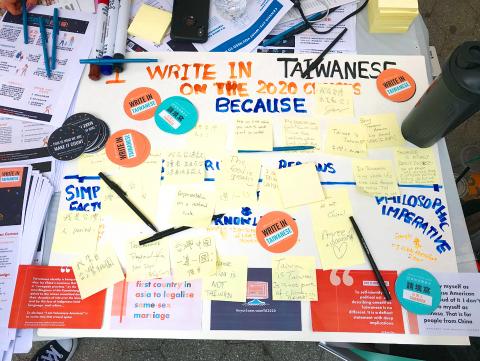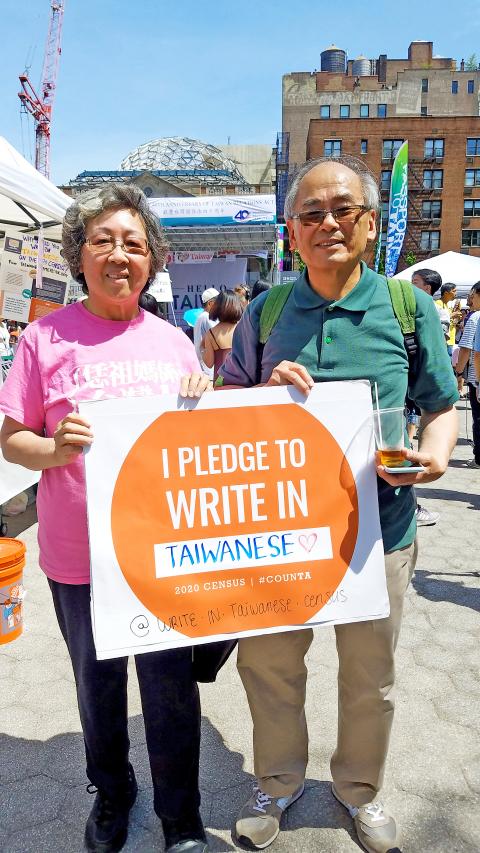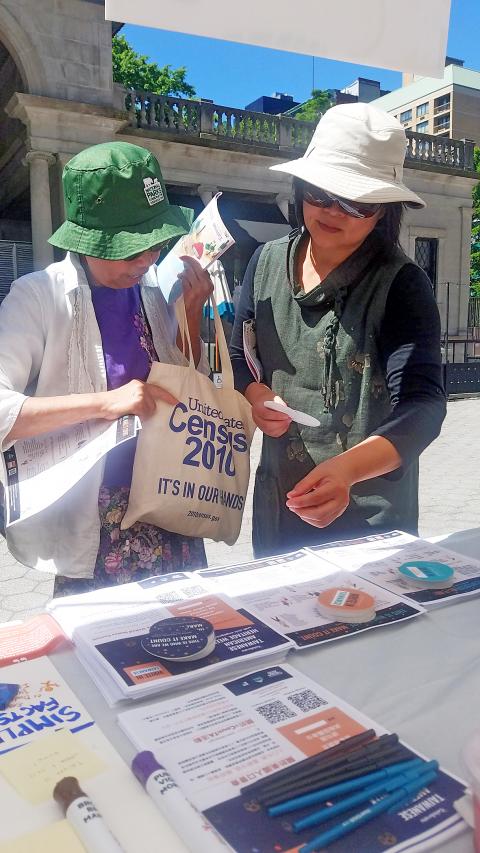With less than a year to go before the 2020 US census, advocates are encouraging Taiwanese respondents to write in “Taiwanese” on the form’s race question instead of just checking off the box for Chinese.
“There is strength and power in numbers, in being noticed by the government,” Christina Hu (胡若涵), a civic engagement director with the nonprofit Taiwanese American Citizens League, says.
Hu, who is helping spearhead the Write In Taiwanese Census 2020 Campaign, says they’ll be pulling out all the stops to convey to Taiwanese the importance of differentiating themselves from Chinese on the congressionally mandated headcount, done once every 10 years.

Photo courtesy of Christina Hu
The league plans to produce two public service announcements in October in English, Mandarin, Hoklo (also known as Taiwanese) and Hakka, Hu says. She adds that they’ll be fundraising for those PSAs beginning this summer.
The group, which organized similar efforts in previous censuses, has also been deploying social media like Facebook and Instagram, using the handle @write.in.taiwanese.census to help spread the message.
“People who identify as Taiwanese [are] not often recognized, and a lot of times we have to defend ourselves,” Ben Ling (林君威), a past president of the Taiwanese American Citizens League, says. “So having this be legitimized where we are actually counted pretty much legitimizes our identity.”

Photo courtesy of Christina Hu
A LOT AT STAKE
The census is used to determine how more than US$800 billion a year in federal funds is allocated, as well as to decide the number of seats awarded to states in the House of Representatives and the way representative boundaries are drawn.
Community advocates have been ramping up efforts to educate the public about the importance of filling out the questionnaire, which, unlike in previous counts, will be completed primarily online in 2020.

Photo courtesy of Christina Hu
But getting people to participate can be tough. A US Census Bureau survey released earlier this year found that Asian Americans were least likely to fill out the census form and were most concerned their answers would be used against them.
This comes amid growing mistrust about how data is used and a Trump administration push to include a citizenship question, which advocates worried would discourage participation in the census.
The US Supreme Court recently tossed the controversial question from 2020 census forms. Following that ruling, the Trump administration said it would omit the question.

Photo courtesy of Christina Hu
Meanwhile, some Chinese Americans, many of them immigrants, have decried government efforts to collect and publish detailed data on Asian Americans and Pacific Islanders, fearing it could be used to advance race-based policies.
Some have even reportedly advocated not answering the census race question, which is used to establish guidelines for federal affirmative action plans and monitor compliance with the Voting Rights Act, among other things.
Advocates worry such actions could generate inaccurate census results. That, in turn, could impact funding levels for programs like Medicaid and food stamps, not to mention grants and loans for state and local governments, companies and nonprofits.

Photo courtesy of Christina Hu
STAND UP AND BE COUNTED
For many Taiwanese, the census is an opportunity to stand up and be counted.
In 2000, the census recorded around 145,000 Taiwanese living in the US, accounting for just 1 percent of all Asians. That number rose to around 215,000 in the last census in 2010, roughly a 50 percent increase.
Yeh Chieh-ting (葉介庭), Ketagalan Media cofounder who is handling media relations for the Taiwanese write-in campaign, attributes the population jump to a similar outreach effort in 2010.
“We’re talking about people over this 10 year period who decided that it was worth their while to bother to check ‘other’ and to write in ‘Taiwanese’ and to spell it correctly,” Yeh says, adding that they’re trying to keep the momentum going for 2020.
Ling says he believes the Taiwanese community was still vastly undercounted in the last census, though a Census Bureau report in 2012 found that Asians in general were not.
The Census Bureau said information about the 2020 census will be mailed out to most addresses beginning next March. People will be able to respond online, by mail or by phone.
The race question allows respondents to mark one or more boxes and write in their origins. It features checkboxes for Chinese, Korean and Japanese, among others, but not for Taiwanese.
The Write In Taiwanese Census 2020 Campaign urges people filling out the census to write in “Taiwanese” if they or their family came from Taiwan, or if they can trace some of their heritage to the country.
Apart from the question of identity, advocates point out that being specific about subgroup on the race question helps expose differences and disparities within the vastly diverse Asian American community.
That nearly four in five Taiwanese in the US have a bachelor’s degree or higher, or that 4 percent of Taiwanese have no health coverage, are statistics that otherwise would get lost if respondents did not write in Taiwanese.
But that data, advocates caution, is accurate only when all Taiwanese living in the US complete the questionnaire — and indicate that, in fact, they are Taiwanese.
“Writing in Taiwanese is important because the community of Taiwanese Americans does exist, with all its heritages and narratives about who we are,” Yeh ays. “So we’d like that to be reflected as accurately as possible in the official government data of the United States.”

Exceptions to the rule are sometimes revealing. For a brief few years, there was an emerging ideological split between the Democratic Progressive Party (DPP) and Chinese Nationalist Party (KMT) that appeared to be pushing the DPP in a direction that would be considered more liberal, and the KMT more conservative. In the previous column, “The KMT-DPP’s bureaucrat-led developmental state” (Dec. 11, page 12), we examined how Taiwan’s democratic system developed, and how both the two main parties largely accepted a similar consensus on how Taiwan should be run domestically and did not split along the left-right lines more familiar in

As I finally slid into the warm embrace of the hot, clifftop pool, it was a serene moment of reflection. The sound of the river reflected off the cave walls, the white of our camping lights reflected off the dark, shimmering surface of the water, and I reflected on how fortunate I was to be here. After all, the beautiful walk through narrow canyons that had brought us here had been inaccessible for five years — and will be again soon. The day had started at the Huisun Forest Area (惠蓀林場), at the end of Nantou County Route 80, north and east

Specialty sandwiches loaded with the contents of an entire charcuterie board, overflowing with sauces, creams and all manner of creative add-ons, is perhaps one of the biggest global food trends of this year. From London to New York, lines form down the block for mortadella, burrata, pistachio and more stuffed between slices of fresh sourdough, rye or focaccia. To try the trend in Taipei, Munchies Mafia is for sure the spot — could this be the best sandwich in town? Carlos from Spain and Sergio from Mexico opened this spot just seven months ago. The two met working in the

This month the government ordered a one-year block of Xiaohongshu (小紅書) or Rednote, a Chinese social media platform with more than 3 million users in Taiwan. The government pointed to widespread fraud activity on the platform, along with cybersecurity failures. Officials said that they had reached out to the company and asked it to change. However, they received no response. The pro-China parties, the Chinese Nationalist Party (KMT) and Taiwan People’s Party (TPP), immediately swung into action, denouncing the ban as an attack on free speech. This “free speech” claim was then echoed by the People’s Republic of China (PRC),